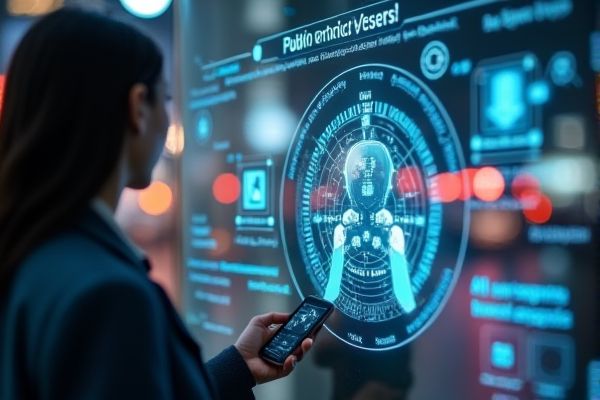
AI enhances public safety through predictive analytics, enabling law enforcement to anticipate and prevent potential criminal activities. Surveillance systems equipped with facial recognition technology improve detection of suspects and missing persons, increasing response efficiency. Emergency response optimization utilizes AI to analyze traffic patterns and deploy resources rapidly during crises. Community engagement applications use chatbots and data analysis to address citizen concerns and improve overall safety communication.
AI usage in public safety
Predictive Policing
AI in public safety, particularly in predictive policing, offers the potential to enhance crime prevention strategies. For instance, law enforcement agencies like the Los Angeles Police Department utilize data-driven algorithms to identify high-risk areas for criminal activity. This approach could lead to more effective resource allocation and timely interventions, thereby improving community safety. The opportunity for increased efficiency and reduced crime rates presents a significant advantage in urban management.
Surveillance Systems
AI technologies in public safety can enhance the effectiveness of surveillance systems by enabling real-time data analysis. For instance, institutions like the New York Police Department are increasingly adopting AI to improve crime prediction and response times. This integration may allow for quicker identification of potential threats, ultimately increasing community safety. The potential advantages include a more efficient allocation of resources and improved situational awareness for law enforcement agencies.
Emergency Response Optimization
AI can enhance public safety by streamlining emergency response through data analysis and predictive modeling. For instance, algorithms can determine optimal resource allocation for fire departments, improving response times and efficiency. Cities can utilize AI to analyze historical incident data and identify crime hotspots, which helps law enforcement deploy resources more effectively. The integration of AI tools has the potential to significantly reduce the impact of emergencies on communities.
Crime Pattern Analysis
AI can enhance public safety through effective crime pattern analysis, enabling law enforcement agencies to identify trends and predict potential criminal activities. By analyzing historical data, such as incident reports from local police departments, AI can help allocate resources where they are needed most. For example, cities may implement AI-driven systems to monitor high-crime areas, increasing the chances of timely intervention. This technology not only provides insights but also offers the possibility of reducing crime rates and improving community safety.
Traffic Management
AI can enhance public safety by analyzing traffic patterns to optimize signals and reduce congestion. For instance, cities like Los Angeles have implemented AI-driven traffic management systems that can adapt in real-time to changing conditions. This technology increases the likelihood of quicker emergency response times by improving vehicular flow. The potential advantages also extend to reducing accidents and improving pedestrian safety through better monitoring.
Disaster Risk Assessment
AI can enhance disaster risk assessment by analyzing large datasets to predict potential hazards and vulnerabilities in specific areas. For instance, institutions like the Federal Emergency Management Agency (FEMA) are utilizing AI algorithms to improve their emergency response strategies. This technology may provide more accurate forecasts, enabling governments to allocate resources efficiently and prioritize at-risk communities. The integration of AI could lead to faster decision-making, ultimately increasing public safety during emergencies.
Threat Detection Algorithms
AI usage in public safety can enhance threat detection algorithms, potentially leading to more effective responses to emergencies. For example, law enforcement agencies may implement AI tools to analyze patterns in crime data, improving resource allocation. These algorithms can process vast amounts of information quickly, increasing the chance of identifying threats early. The integration of AI in this context could provide significant advantages in ensuring community safety and preparedness.
Resource Allocation Efficiency
AI can enhance resource allocation efficiency in public safety by analyzing data patterns to identify high-risk areas. For instance, predictive policing models can allocate police presence more effectively based on crime data analysis. This could lead to reduced response times and better incident management. By optimizing resources, agencies like the local fire department may respond more efficiently to emergencies, potentially lowering overall risks to the community.
Incident Reporting Automation
AI can enhance public safety through automated incident reporting systems, which streamline data collection and reporting processes. For example, city police departments can adopt AI technologies to analyze crime patterns and predict potential incidents. This capability may allow for more efficient resource allocation and quicker response times, potentially reducing crime rates. The use of AI in this context provides a chance for law enforcement agencies to improve community trust and safety.
Public Awareness Campaigns
AI can enhance public safety through predictive policing and real-time incident response systems. For example, a city might implement AI algorithms to analyze crime patterns, allowing law enforcement to allocate resources more effectively. Public awareness campaigns can leverage AI to tailor messages that resonate with specific community demographics. The potential for increased engagement and education on safety practices may lead to a significant reduction in crime rates.
 techknowy.com
techknowy.com